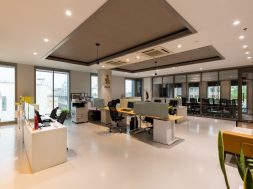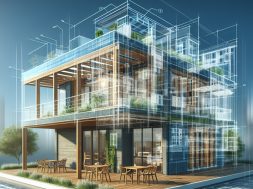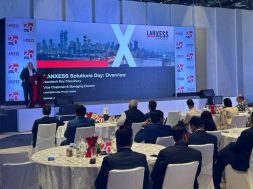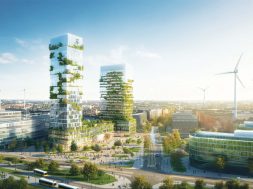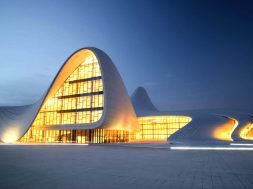On Killing a Tree

Gieve Patel’s famous poem starkly reflects the brutality of human actions toward nature and the urgent need to reconsider our relationship with the environment. It serves as a call for sustainability and respect for the Earth’s resources. The construction industry is one of the most active industries worldwide and a major consumer of energy, natural resources, and minerals. The stakeholders must urgently reduce their environmental impact and move towards sustainable construction methods.
The primary objective of sustainable construction is to reduce the environmental impact by transitioning to sustainable construction methods, focusing on energy efficiency, reducing waste, and adopting green technologies. Several construction companies worldwide are now recognising the significance of sustainable construction practices. The last decade has seen several advances in materials, technology, and practices that promote sustainability in construction. By appropriately combining materials, technology, and practices, sustainability in construction can be achieved efficiently and early. Besides being beneficial to the environment, sustainability in construction also supports the long-term well-being of residents and communities.
In an online interaction organised by the ACE Update Magazine, acclaimed architects with expertise in sustainable practices share their views on the various aspects of sustainable construction in India, including the choice of materials, the importance of site selection, passive design strategies, and technologies.
Site planning
Ar. Komal Kotwal, Founder & Principal Consultant of EquiSustain, discusses the various aspects of sustainable site planning. “Sustainable site planning needs to be looked at holistically. First, what impacts can the site plan have on water management? Is it low-impact site development for stormwater or rainwater management? Second, does your site planning help reduce heat island effects, especially in urban contexts? Also, are there provisions to mitigate the effect? Third, does the plan positively impact the quality of life of the occupants? And, is the site plan making the environments liveable and pedestrian-friendly, both in terms of access, encouraging an active lifestyle where people can walk around, etc.?” opines Komal.
Ar. Bijal Parikh, Sr. Project Manager, SSA Architects, adds her views on the factors to be considered during site planning. “I would say, in site planning, first you must understand the context. What are you building, and for whom are you building? Along with understanding the site’s geography, one needs to understand the site’s ecology as well. For example, if the site is in a rainfall-prone region, plans have to be in place for rainwater management, which is a priority.”, says Bijal.
Role of technology
Ar. Gaurav Varmani, CEO & Co-Founder of studio LINEDESIGN, offers his perspectives on how technology augments sustainable construction methods. He says, “Today, you have very strong technological innovations happening in every construction area. For example, smart sensors and IoT are bringing up energy efficiency in a large way. Energy modelling software helps integrate renewable energy from components like solar panels and wind turbines. Technologies like 3D printing, AI, and machine learning play a large role in sustainable material selection and management, waste management, and materials recycling, all of which are part of sustainable construction initiatives. Advancements like technology-driven recycling systems, green roofs, rainwater harvesting, smart plumbing systems, GIS simulations, and life cycle assessment tools are also contributing to sustainability in construction in a significant way.”
Passive design strategies
Ar. Gaurav Mathur, Proprietor & Principal Architect at GMG Architecture, shares his views on the role of passive design strategies in sustainable architecture. “Passive design is the most intrinsic part of the design process. Design strategies encompass having the right orientation, the right materials, and the right kind of approach towards making layouts. The orientation should allow maximum heat during winters and moderate excess heat during summers. Aspects like the number of sunshades, shading devices, the kind of glass to be used, etc., should all be included in the design. Passive design strategies should include process-driven designs related to shading devices, building materials, paints, etc., and ensure that spatial quality or spatial health factor does not deteriorate.” Gaurav.
Collaborative approach
Ar. Sonal Khopkar, Associate—Design Management, Kapadia Associates, shares her insights on why a collaborative approach among stakeholders is essential. “It is more than necessary to have everyone’s goals aligned from the very start, especially for large buildings, to ensure smooth functioning and to achieve long-term sustainability goals.”
Sustainable materials
“There are both locally available materials and technology-driven materials. But, before choosing a material, it is important to understand its life cycle, how it will work across the entire life of the building, if it is durable or requires frequent repair and replacement, etc.” opines Bijal.
“The material selection depends on the project, location, and purpose. For example, materials used for creating a healthcare structure differ from those used for creating an office space or a commercial building. Architects should also be informed of the manufacturing process of the materials, the energy and labour involved in the process, and if the processes align with the ethical principles.,” adds Komal.
Sonal opines, “The context makes a huge difference. The choice of material changes with the scale, usability, and typology of the project/building. There should be a lot of recycled materials that should come into the mainstream now, and we should be more open to adopting these rather than sometimes being hung up on, laying down criteria or certain aesthetic requirements.”
Gaurav Mathur adds, “In the Indian context, designers and architects must rethink the proportion of usage of certain materials. For example, glass is being used quite extensively. But, we should not be imitating the Western culture, and the use of glass should be minimised in the Indian context.”
Cookie Consent
We use cookies to personalize your experience. By continuing to visit this website you agree to our Terms & Conditions, Privacy Policy and Cookie Policy.

